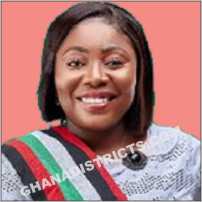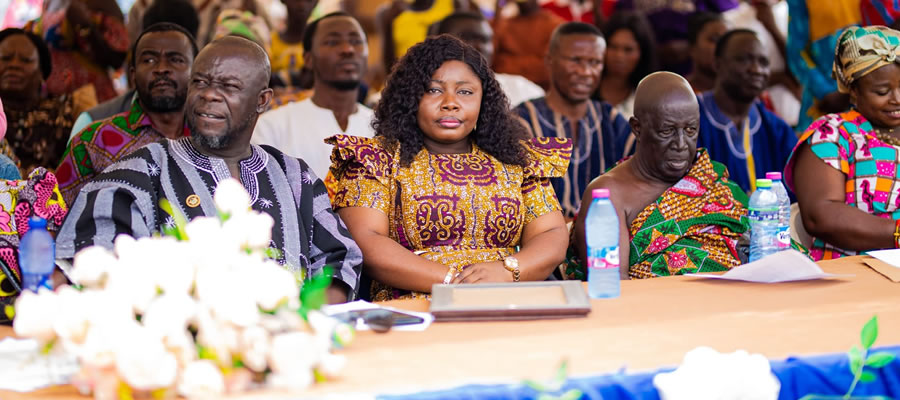

Service/Commerce Sector
The informal sector plays a dominant role in this sub sector. Their role is however, complimented by the formal sector through the services provided by departments of the District Assembly and other government organizations such as the police and the courts.The informal sector comprises hairdressers, tailors, barbers, drivers, painters, etc. Their area of operation is scattered in various communities in the district and they operate in kiosks and stores, often rented. They sometimes train apprentices who support them in their daily business activities.
In the district, the commercial sub-sector comprises both retailers and wholesalers. It is however, worthy to note that retailers out number wholesalers. Both individuals and organized institutions engage in commercial activities in the district. It is however, obvious that individuals dominate this sector. Manufactured goods that are sold include roofing sheets, ply wood, iron rods, cement, cutlasses, consumables and other chemical products such as hair creams and fertilizers.
Business activities are conducted in wooden structures, rented stores and stalls in the markets, on tables in open spaces and private buildings in various communities. Wholesale business activities are mainly found in bigger settlements like Afrancho and Buoho. It is worthy to note that due to improved access and transportation, a considerable number of people in the district acquire manufactured goods from Kumasi. By implication, the full advantages of trade and commerce have not been realized in the district. The service sector also consists of those in health, education, postal and telecommunication (mobile phone repairs, sale of top-up units) and banking sectors.
Inter and Intra Trade
There is yet to be established data on inter and intra trade in the District. Despite the absence of concrete data, it is obvious that there is more of inter than intra trading activities. The District produces more of agriculture produce than any other.
These produce which are both food and cash crops are sold outside the District to places such as Takoradi, Accra, Tema and Kumasi. In turn, items like building materials, clothing, kitchen wares, etc. are imported into the District from these cities.
This trend creates opportunities for the business community in the district to invest in wholesale and distribution sectors which will create jobs, increase incomes and broaden the revenue sources of the District Assembly.
Physical Accessibility to Services
Services are provided within a geographic setting to serve a given threshold population. Physical accessibility studies have been undertaken to determine areas that are easily accessible to facilities and services within the district that are not necessarily in their localities. Five services and facilities have been considered. These are:
• Health Hospital/Health Centre
• Education 2nd Cycle Institution
• Market weekly/Periodic Market
• Banking Commercial/Rural Banks
• Agriculture Agric Extension Service
In assessing physical access to facilities and services, various roads in the district were classified and defined according to the conditions and frequency of transport on the road. The district has a total of 180.2 Km of road length, of which 80% is untarred. Four main types of roads were identified in the district as shown in Table 1.17:
Accessibility to Health
Hospital/Health Centres were identified in thirteen Communities in the district. These are Afrancho, Kodie, Brofoyedru, Kwaman, Adwumakasekese, Aboabogya, Ejuratia, Bronkron, Atimatim, Mowire, Ahenkro, Boamang and Kyekyewere. The analysis revealed that accessibility to Hospital and Health Centers in the district is very high in and around the district capital as shown in Figure 1.14. Health facilities in the District are fairly distributed which makes it easily accessible by the majority of the populace. This is so because as much as five service centers were identified in the area. It is important to state that about 80% of the communities are either within the high or medium access zones. Those within the low and least zones are as a result of the fact that majority of these settlements are mainly farming hamlets and cottages whose individual threshold population cannot support even level “A” health facility which requires a threshold population of 2500.
The population of individual hamlets and cottages of the area ranges between five (5) households to 16 households with an average household size of 5 people. It is worth noting that even though their individual threshold population cannot support the least level of health delivery, the sum total of population of hamlets in the area suggest that a relatively high number of the people do not have adequate access to health facility.
Accessibility to Second Cycle Institutions
Second Cycle Institutions have been classified to include senior secondary schools, technical schools and vocational schools. Five service centres were identified in the following Communities: Bronkrong, Afrancho, Tetrem, Mowire, Aduman, Boamang and Heman-Buoho (see Figure 1.15). Again, the situation suggests the concentration of facilities in the Southern portion of the district. Over 71% of second cycle educational institutions are located in this portion of the district. The Northern portion enjoys only 29% of the facility.
Accessibility to Agriculture Extension Services
The mainstay of the local economy of the district is agriculture. The sector employs 61% of the total labour force of the district. This prompted the assessment of physical accessibility to agricultural extension services in the district. A total of six (6) service stations were identified (see Figure 12). About 65% of the district has access to agric extension services.
Again, the area on the map which depicts poor access zone is a very important farming area. It is virtually the food basket of the district. This is a clear indication of the fact that not all inhabitants have access to the services of agricultural extension. Again, the situation means that the area would have done better if it had good access to the services of an agricultural extension services. Major Communities with poor access include Oyera, Abidjan, Adukro etc. In fact access to Agricultural services would not have been a problem if the Agricultural Extension Agents (AEA) were well resourced in terms of transportation.
Accessibility to Banking Services
Capital formation for investment lies in the purview of the banking institutions in the district. To this end, efforts were made to assess the physical access to banking facilities by the people of the district. Commercial and Rural Banks in the district were considered. Unfortunately only three (3) service centers were identified in the district which is also located at the extreme ends of the District leaving the entire middle portion orphaned (see Figure 1.17). The 3 facilities are all Rural Banks located at Afrancho Boamang and Tetrem as shown in figure 1.4 overleaf.
It can therefore be said that the low access to banking services is a barrier to development as most of the people travel far outside the District before they can access banking services. The analysis revealed that about 85% of the district has access to banking services. This suggests that physical access to a bank in the district is not a barrier to development.
Accessibility to a Weekly/Periodic Market
The district can boast of six relatively key periodic markets. The studies revealed that about 80% of the district has access to a periodic market. The market centres are located in Ankaase, Wawase, Kwamnag, Tetrem, Kyekyewere and Boamang (see Figure 1.18). The situation indicates that the problem of post-harvest losses in the district is not with access to marketing centres but with storage system and processing, and calls for effective storage system for the farmers in the district.
Aggregate Accessibility
This is a sieve map indicating areas of the district that have access to at least a facility. All the communities have access to at one facility (see Figure 1.19). So there is 100% coverage in terms of aggregate accessibility. This is an indication that the District should focus more on the improvement of the quality of the services available.
Aggregate Accessibility
This is a sieve map indicating areas of the district that have access to at least a facility. All the communities have access to at one facility (see Figure 1.19). So there is 100% coverage in terms of aggregate accessibility. This is an indication that the District should focus more on the improvement of the quality of the services available.
ICT, Post and Telecommunication Facilities
The District has two (2) postal agencies, three (3) internet facilities and twenty (20) community information centers. Again, there is a high rate of cell phone coverage in the District. Almost every community has a good reception level in terms of cell phone. Despite this the rate of tele-density is relatively low i.e. about 5:1 due to poverty.
The district also has three (3) ICT centres of which two (2) are functional. There is therefore a solid potential for ICT education in the district.
In addition, three (3) secondary schools in the district have centres for ICT education. Several primary and JHS schools in the district also have computer laboratories for ICT education. In fact, effort is being made by all school and in some communities to own ICT centres to promote Information and Communication Technology education in the district.
Date Created : 11/14/2017 5:12:00 AM












 facebook
facebook
 twitter
twitter
 Youtube
Youtube
 +233 593 831 280
+233 593 831 280 0800 430 430
0800 430 430 GPS: GE-231-4383
GPS: GE-231-4383 info@ghanadistricts.com
info@ghanadistricts.com Box GP1044, Accra, Ghana
Box GP1044, Accra, Ghana